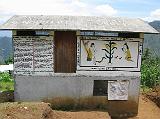The municipality of Tepetzintla is located in the Northern Sierra of Mexico,
it is a mixed ethnic municipality with both Nahuatl and Totonacan speaking peoples.
It is among the most isolated and poor places in the state of Puebla. On three separate occasions I attempted to reach Tepetzintla but due to road construction and the wrong vehicle I was held back from exploring this incredible beautiful area. I first was in contact with the belt weavers of Tepetzintla while documenting in Huitzilan, Puebla, which is a municipality located near the Trans Serrano highway in Puebla. I met two women , one was selling back strap woven belts and the other mecapales , the head strap used to carry good and firewood in the Sierra. . Both of these item strongly suggested a large indigenous presence. In fact after researching the area over 90 percent of the municipality speaks either Nahuatl or Totonacan. Then again while in the Municipality of Ahuacatla, Puebla, the gateway to Tepetzintla I found during the Sunday market 6 or 7 women spinninh cotton or wool using the traditional malacateras , or manual spinning device. This was the first attept to reach Tepetzintla however due to floods in the local area I was advised by the peope on the paved part of the road not to go ahead. My second attepmt from the Ahuacatlan side met with the same results, so I decided I would go around the mountain and come in from the bck side , where only dirt roads existed. So I rented a truck and after the discovery of cuautempan en route I was able to reach Chicometepec, where I met a bi lingual family whose dautgh Olivia a generous and friendly resident, who took me around to visit belt makes, furniture makes , wool spinners and weavers and did the translating for me. Please explore these galleries and enjoy the panoramic views and the resistent and culturally strong peoples that live here. During to a visit to one of the towns I found a poem written on the side of a building . It is about the importance of Corn to the indigenous population. Here is the translation.
To My son :
A poem - “Tata maiz” ( grandfathercorn)
Corn is not to be thrown away
Nor to trample on it
Nor forget it
Because corn means our lives and the life of god
The Corn is our Father and our Mother
It is also our sons
Corn is us ( male and female)
Corn is our Father and Mother , because
it gives us life
Because it gives us unity and identity
Like children from the same family and
community
It shows us to love our mother earth and not to abandon her
Through corn rituals and offerings we discover God ,
Corn is our father and mother because we inherited our bodies, our blood and our heart
Through corn , we inherited our color and our language.
It shows us the universe and to celebrate our the knowledge of our people and family
Corn is our father and mother because
When we are sick it provides medicine
WE have to treat it like a son,
We have to take care of it
We have to cultivate it, so it is always with us and never leaves
We have to give it our respect
to My son – respect it , because
there ( in the Corn) are your grandparents and there you are too.
Communities indigenous unidos para la defense del Maiz and our culture In the center of the municipality is Toanixco , which is a Totonacan speaking town, the wrap skirts are the same black wool , however the wide back srap woven belts and the embroidered blouse . The quechquemilt while similar store bought lace is not worn in the same way and is slightly smaller. Bob Freund
In the center of the municipality is Toanixco , which is a Totonacan speaking town, the wrap skirts are the same black wool , however the wide back srap woven belts and the embroidered blouse . The quechquemilt while similar store bought lace is not worn in the same way and is slightly smaller. Bob Freund







